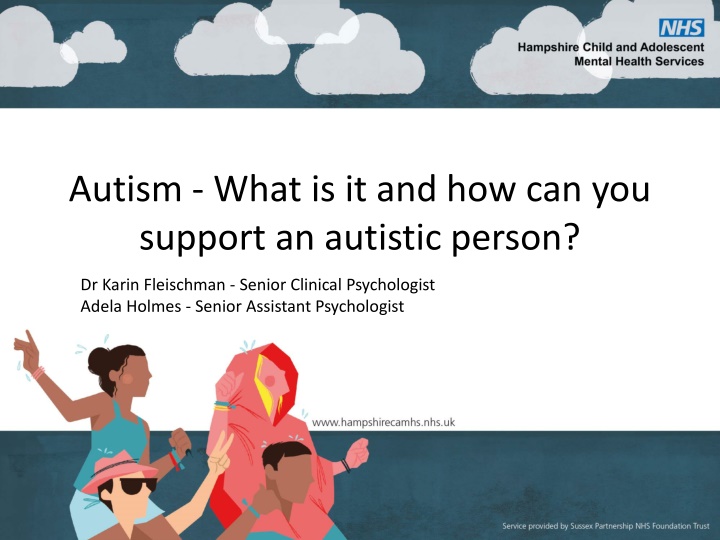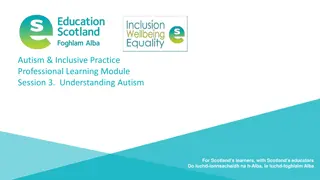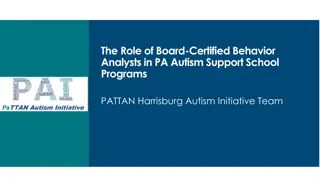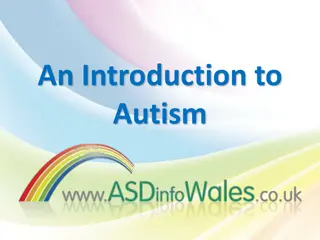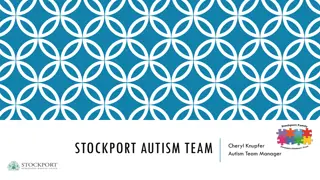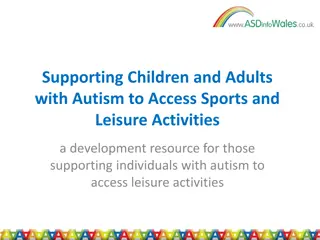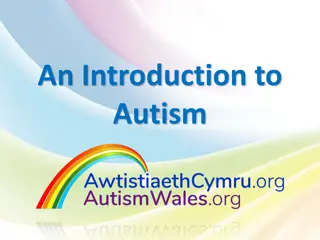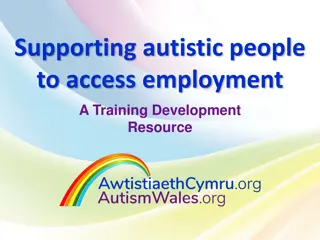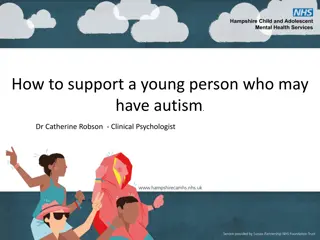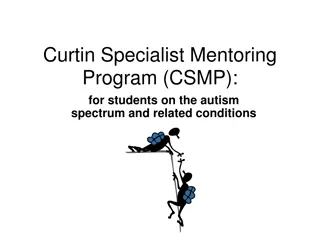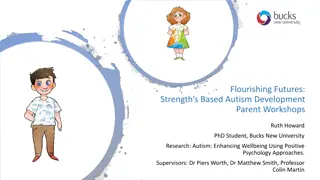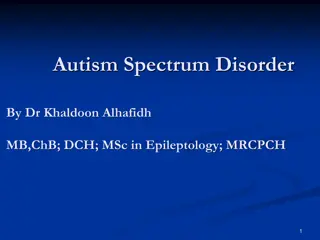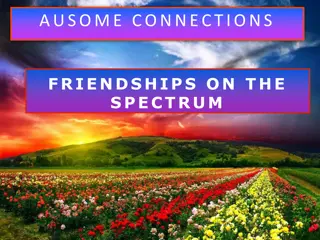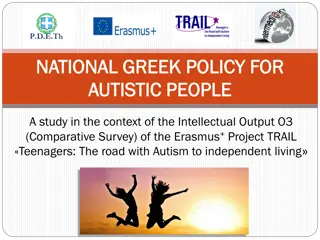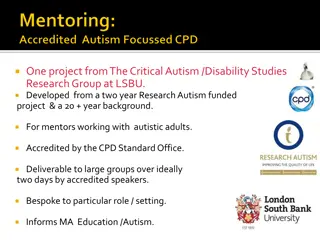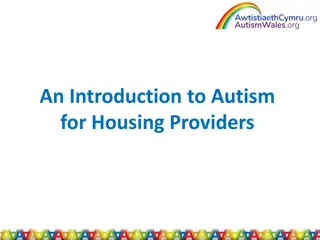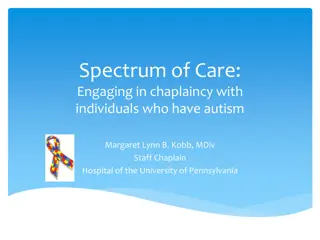Autism - What is it and how can you support an autistic person?
Autism Spectrum Disorder (ASD) is assessed using DSM-5 criteria, focusing on impairments in emotional reciprocity, relationships, and communication. Individuals may also display difficulties in movements, routines, interests, and sensory needs. Beyond ASD, considerations include ADHD, anxiety disorders, sensory processing issues, learning difficulties, trauma responses, and mood challenges. A diagnosis can promote awareness, self-understanding, relief, and access to appropriate support. However, some individuals may struggle with or reject a diagnosis due to self-acceptance concerns or potential discrimination in certain environments.
Download Presentation

Please find below an Image/Link to download the presentation.
The content on the website is provided AS IS for your information and personal use only. It may not be sold, licensed, or shared on other websites without obtaining consent from the author.If you encounter any issues during the download, it is possible that the publisher has removed the file from their server.
You are allowed to download the files provided on this website for personal or commercial use, subject to the condition that they are used lawfully. All files are the property of their respective owners.
The content on the website is provided AS IS for your information and personal use only. It may not be sold, licensed, or shared on other websites without obtaining consent from the author.
E N D
Presentation Transcript
Autism - What is it and how can you support an autistic person? Dr Karin Fleischman - Senior Clinical Psychologist Adela Holmes - Senior Assistant Psychologist
You can download the slides from the Hampshire CAMHS website and the QR code is on the Top Tips Sheet in your information pack. Please complete the feedback form this helps us improve based on feedback and also demonstrates need. If you score less than a 6 please tell us why! If you have any further questions please visit the CAMHS stand or the person on the PACE reception desk.
Autism Spectrum Disorder CAMHS use the DSM-5 criteria to assess for Autism Spectrum Disorder For a diagnosis, a person must present with impairing difficulties in: Emotional Reciprocity Understanding, forming and maintaining relationships Non-Verbal Communication They must also show difficulties in at least 2 of the following areas: Movements and Speech Routine and managing change Restricted interests/obsessions Sensory needs
Doesnt meet the required criteria? What else? ADHD Anxiety Disorders Sensory Processing Disorders Learning Difficulties Response to trauma Mood difficulties Look at a person s presenting needs listen to the child s voice, work with what you see; work alongside parents and professionals involved, to support them
Why a diagnosis may be useful: Awareness of a person s needs, behaviours and consider what adaptations might be useful Diagnosis may support a person to understand themselves better, and accept themselves Relief and confidence as a parent and as the person Access to appropriate support for parents and the young person
Why a diagnosis may NOT be useful: A child/person can struggle to accept a diagnosis of ASD When a child does not want a diagnosis, or are unaware of a diagnosis (possibly from when they are younger), it: Can increases the risk of not accepting self Can lead to further mental health difficulties Some employers may require specific abilities/characteristics that autistic people cannot meet i.e. Military Careers are often harder to obtain due to risk/set-up of role Other people - direct or indirect discrimination (legally, this should not occur)
Diagnosis - Myths Busters You need a diagnosis in order to be given the support you need If they get a diagnosis, they can get an EHCP in place A diagnosis will make my child feel better about themselves A diagnosis means there is a medical or therapeutic treatment to make it better We don t see the same thing as , so it must mean they re not autistic They are autistic, they need mental health input to make things easier
Diagnosis Myths Busters A diagnosis does not make someone eligible for Disability allowances or an EHCP If a child is SEN registered at school, children are eligible for support without an EHCP. For more information, please access the SEN website: https://www.hants.gov.uk/socialcareandhealth/childrenandfamilies/specialneeds A diagnosis can help a person to understand themselves, and be more compassionate, however, some people really struggle to accept a diagnosis. Acceptance and equality is the most helpful/supportive thing for anybody Masking is a concept that is becoming more recognised. Many people with a disability, such as Autism, will try to fit in in social situations, which can then have an impact on their behaviours elsewhere or their own well-being There is no cure for Autism, but autistic people and those around them can make adaptations to the environment to make things easier CAMHS are currently commissioned for assessment only. The reason a person with Autism would remain open to the service is if they have an enduring mental health difficulty.
What you may notice The challenges Understanding others what other people think, feel, do and why; other people having difficulty understanding their behaviours Understanding their own thoughts, feelings, physical sensations and behaviours. Differences in how autistic people communicate and understand others communication e.g. language, behaviour, facial expression, gesture Difficulty understanding relationships, social rules and situations identifying healthy vs unhealthy relationships Difficulties forming and maintaining friendships or relationships Difficulty in imagination- in play, predicting future options/outcomes Fixed ways of thinking and behaving; dislike of change. Their way or the high way Sensory sensitivities and interests Special interests
We should aim for Autistic children and adults to be proud and happy with who they are. This starts by changing our perspectives of Autism and being strength-focused. The aim is never to change the person. The aim is understand how they might experience things and what might help them.
What professionals have to follow: Autism Act Equality Act Education Act All professionals/employers have the duty to implement Reasonable Adjustments so that those with a disability are not at a disadvantage. Autism is a hidden disability and so this duty is often not fulfilled .
How to help Ask the question why the behaviour? Autism + Environment = Outcomes Luke Beardon
Communication tips: Be clear and unambiguous Be concrete, not abstract in requests and information Make sure the words match your tone, facial expression, gesture. Use short / one instruction at a time Provide clear and consistent rules and boundaries and how you would like them to follow these Use visual means to support whatever their ability Use concrete props e.g. books, factual information Allow time for processing Provide information verbally and visually
Increase predictability and routine Coping with change involves having to manage uncertainty Use visual timetables (calendars, diaries ) Daily routine and planning for changes e.g. timetable Use predictable daily routines to add security and containment e.g. what happens at mealtimes, bedtimes If something changes, let them know, e.g. daily check in at school Plan and prepare visit, look at pictures, plan coping strategies. Talk through what they can expect in new situations. Use timers and countdowns Plan for waiting unstructured time can be overwhelming Involving the young person with making plans e.g. school trips Sharing plans when you know there is a high possibility this will occur and pre-empting and planning for unexpected changes.
Sensory behaviour interests and sensitivities Autistic children tend to experience sensory information differently. Some unusual behaviours can be linked to children trying to manage their sensory sensitivities Notice what is happening in the environment - adjust noise, lighting, crowds, space, physical pressure Some children may need more or less stimulation to help them function at their best
Sensory intervention Planning: Be aware. Look at the environment to see if it is creating difficulties. Can you change anything? Be creative. Think of some positive sensory experiences. Be prepared. Tell the person about possible sensory stimuli they may experience in different environments. Strategies: Movement breaks, deep pressure, chews, move and sit cushions, fiddle toys, suck/ blow activities, soothing activities How to communicate/recognise when there is unavoidable sensory overload or sensory seeking behaviour.
Supporting social understanding and inclusion Help them to recognise and name people/items Help them to learn about their emotions Emotional literacy programs Scaling the Incredible Five Point Scale Pictures of emotions to match to real life Use their special interests to find safe social opportunities or to help explain things (e.g. what would Iron Man do? What was he thinking?) Seek supportive, structured social spaces - lunchtime clubs? Find jobs and tasks for them to highlight their strengths and help others Allow space for a social break downtime Talk about healthy vs unhealthy relationships- use social stories or previous scenarios to support understanding
Build their coping and resilience Skills and toolbox Promote coping strategies and abilities in all areas: Physical i.e. exercise/sensory activities Relaxation Mindfulness / activities to calm Social build + develop their skills Communication practice for situations, be present to support, have a system ready for them if they become stuck Thinking support flexibility visually lay out options Sensory have access to things they like, pre-empt/plan to avoid unnecessary sensitivities
Support available: National Autistic Society www.autism.org.uk Autism Hampshire www.autismhampshire.org.uk Barnados Specialist Parenting Support Hampshire Specialist Parenting Support Service | Barnardo s ASK ABOUT AUTISM BRAAIN/HPCN https://www.braain.co.uk/ask-about-autism. Any questions?
